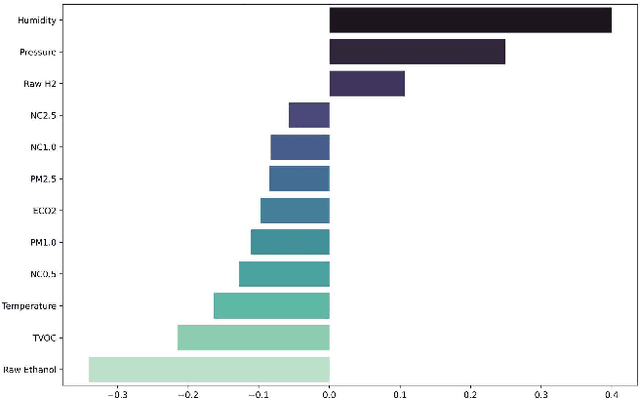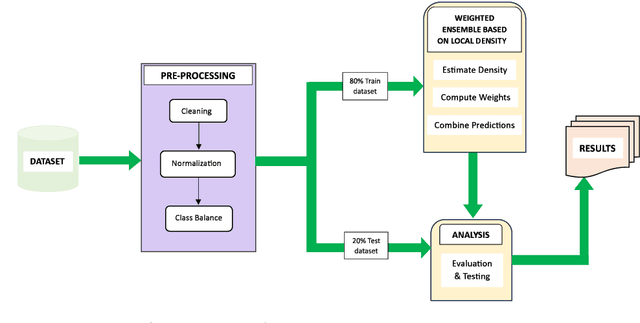Wadii Boulila
NTIRE 2025 Image Shadow Removal Challenge Report
Jun 18, 2025Abstract:This work examines the findings of the NTIRE 2025 Shadow Removal Challenge. A total of 306 participants have registered, with 17 teams successfully submitting their solutions during the final evaluation phase. Following the last two editions, this challenge had two evaluation tracks: one focusing on reconstruction fidelity and the other on visual perception through a user study. Both tracks were evaluated with images from the WSRD+ dataset, simulating interactions between self- and cast-shadows with a large number of diverse objects, textures, and materials.
GATE: General Arabic Text Embedding for Enhanced Semantic Textual Similarity with Matryoshka Representation Learning and Hybrid Loss Training
May 30, 2025Abstract:Semantic textual similarity (STS) is a critical task in natural language processing (NLP), enabling applications in retrieval, clustering, and understanding semantic relationships between texts. However, research in this area for the Arabic language remains limited due to the lack of high-quality datasets and pre-trained models. This scarcity of resources has restricted the accurate evaluation and advance of semantic similarity in Arabic text. This paper introduces General Arabic Text Embedding (GATE) models that achieve state-of-the-art performance on the Semantic Textual Similarity task within the MTEB benchmark. GATE leverages Matryoshka Representation Learning and a hybrid loss training approach with Arabic triplet datasets for Natural Language Inference, which are essential for enhancing model performance in tasks that demand fine-grained semantic understanding. GATE outperforms larger models, including OpenAI, with a 20-25% performance improvement on STS benchmarks, effectively capturing the unique semantic nuances of Arabic.
SARD: A Large-Scale Synthetic Arabic OCR Dataset for Book-Style Text Recognition
May 30, 2025Abstract:Arabic Optical Character Recognition (OCR) is essential for converting vast amounts of Arabic print media into digital formats. However, training modern OCR models, especially powerful vision-language models, is hampered by the lack of large, diverse, and well-structured datasets that mimic real-world book layouts. Existing Arabic OCR datasets often focus on isolated words or lines or are limited in scale, typographic variety, or structural complexity found in books. To address this significant gap, we introduce SARD (Large-Scale Synthetic Arabic OCR Dataset). SARD is a massive, synthetically generated dataset specifically designed to simulate book-style documents. It comprises 843,622 document images containing 690 million words, rendered across ten distinct Arabic fonts to ensure broad typographic coverage. Unlike datasets derived from scanned documents, SARD is free from real-world noise and distortions, offering a clean and controlled environment for model training. Its synthetic nature provides unparalleled scalability and allows for precise control over layout and content variation. We detail the dataset's composition and generation process and provide benchmark results for several OCR models, including traditional and deep learning approaches, highlighting the challenges and opportunities presented by this dataset. SARD serves as a valuable resource for developing and evaluating robust OCR and vision-language models capable of processing diverse Arabic book-style texts.
Advancing Arabic Reverse Dictionary Systems: A Transformer-Based Approach with Dataset Construction Guidelines
Apr 30, 2025Abstract:This study addresses the critical gap in Arabic natural language processing by developing an effective Arabic Reverse Dictionary (RD) system that enables users to find words based on their descriptions or meanings. We present a novel transformer-based approach with a semi-encoder neural network architecture featuring geometrically decreasing layers that achieves state-of-the-art results for Arabic RD tasks. Our methodology incorporates a comprehensive dataset construction process and establishes formal quality standards for Arabic lexicographic definitions. Experiments with various pre-trained models demonstrate that Arabic-specific models significantly outperform general multilingual embeddings, with ARBERTv2 achieving the best ranking score (0.0644). Additionally, we provide a formal abstraction of the reverse dictionary task that enhances theoretical understanding and develop a modular, extensible Python library (RDTL) with configurable training pipelines. Our analysis of dataset quality reveals important insights for improving Arabic definition construction, leading to eight specific standards for building high-quality reverse dictionary resources. This work contributes significantly to Arabic computational linguistics and provides valuable tools for language learning, academic writing, and professional communication in Arabic.
NTIRE 2025 Challenge on Image Super-Resolution ($\times$4): Methods and Results
Apr 20, 2025Abstract:This paper presents the NTIRE 2025 image super-resolution ($\times$4) challenge, one of the associated competitions of the 10th NTIRE Workshop at CVPR 2025. The challenge aims to recover high-resolution (HR) images from low-resolution (LR) counterparts generated through bicubic downsampling with a $\times$4 scaling factor. The objective is to develop effective network designs or solutions that achieve state-of-the-art SR performance. To reflect the dual objectives of image SR research, the challenge includes two sub-tracks: (1) a restoration track, emphasizes pixel-wise accuracy and ranks submissions based on PSNR; (2) a perceptual track, focuses on visual realism and ranks results by a perceptual score. A total of 286 participants registered for the competition, with 25 teams submitting valid entries. This report summarizes the challenge design, datasets, evaluation protocol, the main results, and methods of each team. The challenge serves as a benchmark to advance the state of the art and foster progress in image SR.
The Tenth NTIRE 2025 Image Denoising Challenge Report
Apr 16, 2025



Abstract:This paper presents an overview of the NTIRE 2025 Image Denoising Challenge ({\sigma} = 50), highlighting the proposed methodologies and corresponding results. The primary objective is to develop a network architecture capable of achieving high-quality denoising performance, quantitatively evaluated using PSNR, without constraints on computational complexity or model size. The task assumes independent additive white Gaussian noise (AWGN) with a fixed noise level of 50. A total of 290 participants registered for the challenge, with 20 teams successfully submitting valid results, providing insights into the current state-of-the-art in image denoising.
Nash Equilibrium Between Consumer Electronic Devices and DoS Attacker for Distributed IoT-enabled RSE Systems
Apr 13, 2025Abstract:In electronic consumer Internet of Things (IoT), consumer electronic devices as edge devices require less computational overhead and the remote state estimation (RSE) of consumer electronic devices is always at risk of denial-of-service (DoS) attacks. Therefore, the adversarial strategy between consumer electronic devices and DoS attackers is critical. This paper focuses on the adversarial strategy between consumer electronic devices and DoS attackers in IoT-enabled RSE Systems. We first propose a remote joint estimation model for distributed measurements to effectively reduce consumer electronic device workload and minimize data leakage risks. The Kalman filter is deployed on the remote estimator, and the DoS attacks with open-loop as well as closed-loop are considered. We further introduce advanced reinforcement learning techniques, including centralized and distributed Minimax-DQN, to address high-dimensional decision-making challenges in both open-loop and closed-loop scenarios. Especially, the Q-network instead of the Q-table is used in the proposed approaches, which effectively solves the challenge of Q-learning. Moreover, the proposed distributed Minimax-DQN reduces the action space to expedite the search for Nash Equilibrium (NE). The experimental results validate that the proposed model can expeditiously restore the RSE error covariance to a stable state in the presence of DoS attacks, exhibiting notable attack robustness. The proposed centralized and distributed Minimax-DQN effectively resolves the NE in both open and closed-loop case, showcasing remarkable performance in terms of convergence. It reveals that substantial advantages in both efficiency and stability are achieved compared with the state-of-the-art methods.
Optimizing Fire Safety: Reducing False Alarms Using Advanced Machine Learning Techniques
Mar 13, 2025



Abstract:Fire safety practices are important to reduce the extent of destruction caused by fire. While smoke alarms help save lives, firefighters struggle with the increasing number of false alarms. This paper presents a precise and efficient Weighted ensemble model for decreasing false alarms. It estimates the density, computes weights according to the high and low-density regions, forwards the high region weights to KNN and low region weights to XGBoost and combines the predictions. The proposed model is effective at reducing response time, increasing fire safety, and minimizing the damage that fires cause. A specifically designed dataset for smoke detection is utilized to test the proposed model. In addition, a variety of ML models, such as Logistic Regression (LR), Decision Tree (DT), Random Forest (RF), Nai:ve Bayes (NB), K-Nearest Neighbour (KNN), Support Vector Machine (SVM), Extreme Gradient Boosting (XGBoost), Adaptive Boosting (ADAB), have also been utilized. To maximize the use of the smoke detection dataset, all the algorithms utilize the SMOTE re-sampling technique. After evaluating the assessment criteria, this paper presents a concise summary of the comprehensive findings obtained by comparing the outcomes of all models.
Exploring Graph Mamba: A Comprehensive Survey on State-Space Models for Graph Learning
Dec 24, 2024



Abstract:Graph Mamba, a powerful graph embedding technique, has emerged as a cornerstone in various domains, including bioinformatics, social networks, and recommendation systems. This survey represents the first comprehensive study devoted to Graph Mamba, to address the critical gaps in understanding its applications, challenges, and future potential. We start by offering a detailed explanation of the original Graph Mamba architecture, highlighting its key components and underlying mechanisms. Subsequently, we explore the most recent modifications and enhancements proposed to improve its performance and applicability. To demonstrate the versatility of Graph Mamba, we examine its applications across diverse domains. A comparative analysis of Graph Mamba and its variants is conducted to shed light on their unique characteristics and potential use cases. Furthermore, we identify potential areas where Graph Mamba can be applied in the future, highlighting its potential to revolutionize data analysis in these fields. Finally, we address the current limitations and open research questions associated with Graph Mamba. By acknowledging these challenges, we aim to stimulate further research and development in this promising area. This survey serves as a valuable resource for both newcomers and experienced researchers seeking to understand and leverage the power of Graph Mamba.
Enhancing Internet of Things Security throughSelf-Supervised Graph Neural Networks
Dec 17, 2024



Abstract:With the rapid rise of the Internet of Things (IoT), ensuring the security of IoT devices has become essential. One of the primary challenges in this field is that new types of attacks often have significantly fewer samples than more common attacks, leading to unbalanced datasets. Existing research on detecting intrusions in these unbalanced labeled datasets primarily employs Convolutional Neural Networks (CNNs) or conventional Machine Learning (ML) models, which result in incomplete detection, especially for new attacks. To handle these challenges, we suggest a new approach to IoT intrusion detection using Self-Supervised Learning (SSL) with a Markov Graph Convolutional Network (MarkovGCN). Graph learning excels at modeling complex relationships within data, while SSL mitigates the issue of limited labeled data for emerging attacks. Our approach leverages the inherent structure of IoT networks to pre-train a GCN, which is then fine-tuned for the intrusion detection task. The integration of Markov chains in GCN uncovers network structures and enriches node and edge features with contextual information. Experimental results demonstrate that our approach significantly improves detection accuracy and robustness compared to conventional supervised learning methods. Using the EdgeIIoT-set dataset, we attained an accuracy of 98.68\%, a precision of 98.18%, a recall of 98.35%, and an F1-Score of 98.40%.
 Add to Chrome
Add to Chrome Add to Firefox
Add to Firefox Add to Edge
Add to Edge